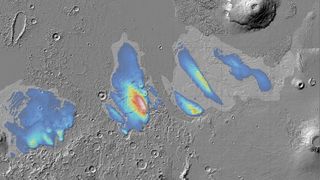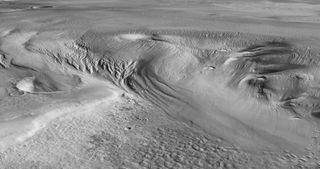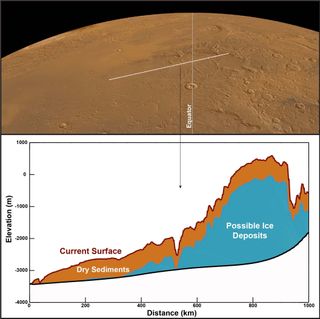Water ice buried at Mars' equator is over 2 miles thick
The Mars Express orbiter has detected enough water ice buried beneath the Red Planet's equator to cover the entire planet in a shallow ocean if melted.

A European Space Agency (ESA) probe has found enough water to cover Mars in an ocean between 4.9 and 8.9 feet (1.5 and 2.7 meters) deep, buried in the form of dusty ice beneath the planet's equator.
The finding was made by ESA's Mars Express mission, a veteran spacecraft that has been engaged in science operations around Mars for 20 years now. While it's not the first time that evidence for ice has been found near the Red Planet's equator, this new discovery is by far the largest amount of water ice detected there so far and appears to match previous discoveries of frozen water on Mars.
"Excitingly, the radar signals match what we expect to see from layered ice and are similar to the signals we see from Mars' polar caps, which we know to be very ice rich," said lead researcher Thomas Watters of the Smithsonian Institution in the United States in an ESA statement.
The deposits are thick, extended 3.7km (2.3) miles underground, and topped by a crust of hardened ash and dry dust hundreds of meters thick. The ice is not a pure block but is heavily contaminated by dust. While its presence near the equator is a location more easily accessible to future crewed missions, being buried so deep means that accessing the water-ice would be difficult.
Related: Mars Express orbiter suggests evidence of ancient microbial life, water and volcanism on Red Planet
Some 15 years ago, Mars Express detected deposits beneath a geological formation called the Medusae Fossae Formation (MFF), but scientists were not sure what those deposits consisted of. Mars' geography is split between northern highlands and southern lowlands, and the huge 5,000-km-long MMF is situated near the boundary between the two.
It is suspected that the MMF itself formed within the past 3 billion years from lava flows and was covered in volcanic ash during an era long ago when Mars was volcanically active. Today, the MMF is covered in heaps of dust towering several kilometers high — it's actually the most plentiful source of dust on the entire planet, fuel for the giant dust storms that can engulf Mars on a seasonal basis. Were the deposits just dust, perhaps filling a deep valley?
Get the Space.com Newsletter
Breaking space news, the latest updates on rocket launches, skywatching events and more!

New observations by MARSIS, which is a subsurface radar on board Mars Express, now have the answer — and it's not dust.
"Given how deep it is, if the MFF was simply a giant pile of dust, we'd expect it to become compacted under its own weight," said Andrea Cicchetti of the National Institute for Astrophysics in Italy in a press statement. "This would create something far denser than what we actually see with MARSIS."
Instead, the deposits are low in density and fairly transparent to MARSIS' radar, which is exactly how one would expect water ice to appear in the data.

More pertinent is the question of how the water ice ended up buried at the equator. Sub-surface ice has been found in plentiful quantities on Mars before; NASA's Phoenix mission dug up ice just beneath the dusty surface at the lander's polar landing site in 2008. Meanwhile, early in its mission, Mars Express detected abundant water-ice extending down into the mid-latitudes, and NASA's Mars Odyssey even found clues to the presence of water in the MMF in 2009.
More recently, ESA's Trace Gas Orbiter detected hydrogen from water ice just beneath the surface of Candor Chaos, which is a segment of the immense rip in the surface of Mars that we call Vallis Marineris. Additionally, the remains of ancient glaciers, called relict glaciers, have been spotted in Eastern Noctis Labyrinthus, which is just 7.3 degrees south of the equator.
The presence of subsurface water-ice at low and equatorial latitudes hints at how Mars' climate was very different in the distant past.
"This latest analysis challenges our understanding of the MFF and raises as many questions as answers," said Colin Wilson, who is an ESA Project Scientist for Mars Express and the Trace Gas Orbiter, in the statement. "How long did these ice deposits form, and what was Mars like at the time?"
The ice's existence could be the result of Mars' wandering axis. Across the Red Planet's history, the axial tilt of the planet's poles is understood to have varied quite chaotically. Currently Mars' poles are tilted to the ecliptic by 25 degrees (compared to Earth, which has a tilt of 23 degrees) but in the past this could have ranged from as shallow an angle as 10 degrees, to as extreme an angle as 60 degrees.
During the periods of high obliquity, when the poles are pointing closer to the sun than the equator, water-ice could form in large quantities on the surface at the equator. That ice could then be buried by ash and dust falls, to remain covered to this day.
The changing obliquity could also explain 400,000-year-old features discovered on Mars by the Chinese Zhurong rover, as well as the existence of gullies formed by liquid water where no such water should have existed.
The new discovery is described in a paper published in Geophysical Research Letters.
Join our Space Forums to keep talking space on the latest missions, night sky and more! And if you have a news tip, correction or comment, let us know at: community@space.com.

Keith Cooper is a freelance science journalist and editor in the United Kingdom, and has a degree in physics and astrophysics from the University of Manchester. He's the author of "The Contact Paradox: Challenging Our Assumptions in the Search for Extraterrestrial Intelligence" (Bloomsbury Sigma, 2020) and has written articles on astronomy, space, physics and astrobiology for a multitude of magazines and websites.
-
zluppen Reply
Hello! Would it be possible to send a link to the GRL paper? I would definitely love to read more about this!Admin said:The Mars Express orbiter has detected enough water ice buried beneath the Red Planet's equator to cover the entire planet in a shallow ocean if melted.
Water ice buried at Mars' equator is over 2 miles thick : Read more -
Seth York Reply
Although its likely unfeasible right now. I would love to see an excavation of these huge buried ice deposits, if there was any life on mars, its possible we may find fossil evidence within it. Who knows how old these are, it may give us a glimpse of a pre dried up marsAdmin said:The Mars Express orbiter has detected enough water ice buried beneath the Red Planet's equator to cover the entire planet in a shallow ocean if melted.
Water ice buried at Mars' equator is over 2 miles thick : Read -
Gibsense Reply
So if we could create a Greenhouse Effect on Mars; say loads of dust in their upper atmosphere equivalent to a few hundred volcanoes ...... nah too irresponsibleSeth York said:Although its likely unfeasible right now. I would love to see an excavation of these huge buried ice deposits, if there was any life on mars, its possible we may find fossil evidence within it. Who knows how old these are, it may give us a glimpse of a pre dried up mars
